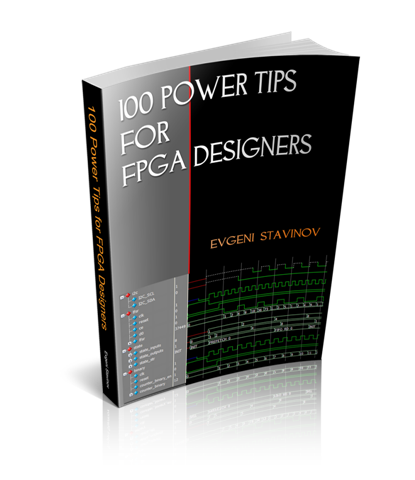Book: 100 Power Tips for FPGA Designers
| Download excerpt from the book | |
|
|
Download source code, projects, and scripts |
 |
Paperback edition on Amazon.com , Amazon.de, and Amazon.co.uk
Number of pages: 474 |
 |
Kindle edition on Amazon.com
The book can be read in color on a PC or MAC using free Kindle for PC or Kindle for MAC application. |
 |
Flipkart.com Readers based in India can purchase the book on Flipkart.com |
 |
www.phei.com.cn Chinese-speaking readers can purchase the book on PHEI |
|
Google eBook edition The book can be read in color on a PC, MAC, Tablet/iPad. Extensive preview is available. |
| ePub edition on Barnes and Noble The book can also be read using free Nook for PC, Adobe Digital Edition applications, or on other eReaders that support ePub format. |
Any questions, comments, suggestions about the book are welcome.

Hello,
I am trying to implement a Synchronous Decade counter with CE in and CE out in a Spartan 3 device that will have a 50% duty cycle. Do you know where I can find a schematic or code for such a device? I have the counter working and all of the outputs seem as they should even on the target FPGA but when I cascade two counters only the first one in a chain has the proper outputs the others do not clock. Any suggestions would be greatly appreciated.
Sam
W3OHM
Hi Sam,
I’d presume that your design can be easily simulated to find the problem.
Thanks,
Evgeni
Well I just got it working today and I strung up a chain of them that divided down a 100MHx Clock (I used the DCM to multiply an external 10MHz clock to 100MHz). Works like gangbusters!
I do have one question. I used a second clock buffer in an attempt to bring the 100MHz multiplied clock out to an external pin. Do you know if this should work as I did not see any activity on the pin even though the counter chain was working properly.
Thanks,
Sam
Hi Sam,
I don’t think you need to manually insert any buffer. Just wire the clock to the IO; tools should automatically insert it.
Thanks,
Evgeni
sir,
I do have one question that with the help of any polynomial when we generate scramler data,at the receiver can we know that which was the polynomial by which we sent the data?or can we recover the polynomial at the receiver?
Hi Rakhi,
If user doesn’t know the data being sent and scrambler polynomial, I presume there is nothing can be done.
If data is known, user can collect a lot of data and try to sweep different polynomials, hoping that one of them will work. But I’m not aware of a generic algorithm that does that.
Thanks,
Evgeni
Hello Evgeni,
what machine did you use as a build server for the build runtime benchmarks in your book? Is it something that is available off-the-shelf like an HP Z800?
Thanks,
Guy.
Hi Guy,
Yes, it was an off-the-shelf Dell server.
Thanks,
Evgeni
Hello,
I am working with behavioral Verilog design. Can you help me to get
an idea about how control flow is flattened out in behavioral Verilog and people
usually claim that control flow in Verilog is obscure and control flow
is encoded in Verilog in data-encoded way.
Can you please give me a small example (say a FSM, or a counter) and help
me to understand that how is control flow in Verilog is encoded in
data-driven way?
I would appreciate any help in this regard.
Many thanks in advance.
Thank You.
Hi Rajdeep,
This is the first time I encounter with “data-encoded way” and “data-driven way” terminology.
But there is at least a couple of different ways to implement control flow statements, e.g. FSM.
This document describes those on page 79: http://www.xilinx.com/itp/xilinx10/books/docs/sim/sim.pdf
Thanks,
Evgeni
Hello Evgeni,
Many thanks for your reply.
I would like to clarify here that what I meant by “data-encoded way”. I am working
with behavioral synthesizable subset of Verilog that allows control-flow statements like if-else and switch(case) but does not allow repeat, for, while, continue statements. So, in a sense, the behavioral code structure in Verilog has a flattened control-flow structure in it (without these loop constructs). This is easy to see because you can model the effect of while or for loops using only if-then-else and switch(case), but in a data-encoded way.
So, the FSM examples you referred has the same modeling with flattened control-flow. Can you please give me some more insight or references on this.
From your experience, did you come across any behavioral Verilog designs that has an explicit control-flow structure which is not flattened. Also, please inform
whether any behavioral synthesis tool allow loop constructs like for, while, repeat, an forever?
Many Thanks in advance.
Looking forward.
Regards,
Rajdeep.
Hi Rajdeep,
The best reference would be the manual for the synthesis tool itself with supported constructs and examples.
As far as I know, pretty much all synthesis tools support for loop, but not while,repeat, and forever. At least the ones I worked with: Xilinx ISE/Vivado, Altera Quartus, Synopsys Synplify and Design Compiler.
I think another way to call flattening of control-flow structure is loop unrolling – this is the term I’m more familiar with.
Thanks,
Evgeni
Hello Evgeni,
Many thanks for your reply.
I agree that loop-unrolling is a popular term used in this context.
Further along the same lines, I am inquisitive to know the following from you.
As “for” loops are synthesizable by behavioral synthesis tool, so
given a behavioral Verilog design with for loop inside it, how does a
behavioral synthesis tool deal with it? Does it always unroll the loop or
does it perform partial unrolling? Depends on what factors.
Can you please share something on this.
Many thanks in advance.
Regards,
Rajdeep.
Hi Rajdeep,
I think exact behavior and limitations are not part of the specification, and depend on the synthesis tool. You need to consult the manual and even talk to tech support of that tool.
But generally speaking, if the loop is unfeasible, for example if it contains so many loops that cannot be unrolled to fit the chip, then it’s going to fail – either during synthesis or place and route.
Another place to get more information are HLS (high level synthesis) tools such as Xilinx Vivado ESL. HLS tools heavily use loop constructs.
Thanks,
Evgeni
Hello Evgeni,
Many thanks for your ideas and references.
Will surely keep in touch.
Regards,
Rajdeep
hi
sir
this is srinivas reddy
i did a project on FPGA implementation of pipelined 2D-DCT and quantization architecture for JPEG image compression
i request u asking a query about above project
Which software and hardware implementation for above project
which algorithm and which language is used for above project
what is the main use of above project
these much of queries asking because i am preparing sops sending to the us universities
please send the answers about above queries
thanking u sir
yours faithfully
SRINIVAS REDDY
Hi Evgeni,
Hope you are fine.
I have a query regarding development of control-path intensive behavioral verilog design. Currently, I have developed a IEEE 754 32-bit floating-point Add/Sub unit in verilog which is quite data-path intensive. But I am looking for a control-path intensive design in Verilog like USB controller, memory controller etc. I got few designs from Opencores but I cannot characterize whether these designs have enough control-path in it just by looking at the code. Can you please tell what are the major characteristics of any control-path intensive designs in Verilog. If I spot
some data-path units, and a FSM in a design, can I consider it as design with
control-path..
Looking forward to your reply.
Many Thanks
Best regards,
Rajdeep
Hi Rajdeep,
As far as I know, there is no clear metrics that distinguishes data-path and control-path intensive designs. You can get some idea by looking at fanouts of control or clock enable signals.
If the design has 8 stages of 256-bit data, that’s 2K fanout. Perhaps the ratio of registers to LUTs is going to be higher in data-path intensive designs.
Thanks,
Evgeni
Hello Evgeni,
Thank you for your reply.
If a design has separate data-path and control-path then the basic
characteristics if such design is that the controller is a FSM which controls
the operations in the data-path. But not all control-path and data-path
mixed model of designs reflects this characteristics due to design complexity.
But isn’t it the case that a control-path intensive design will always have a FSM
controller to control circuit operations and the complexity of the design depends
on the number of states in the FSM controller. Isn’t this a metric to characterise
control-path intensive designs.
Please correct me if I am wrong.
Best regards,
Rajdeep
Hi Rajdeep,
Such a control-path intensive design might also have a lot of control logic with FSMs inside the datapath.
One example is packet processor, which does packet matching, classification, and filtering in each stage of the datapath. In addition, there is a large FSM that controls datapath operation.
So by looking at characteristics of such a design, it’s not clear that it is control-path intensive.
Thanks,
Evgeni
Hello Evgeni,
Many thanks for the clarification.
Also, I got a USB 1.1 physical Interface core from Opencores
but I am totally not sure if it contains enough control-path in it.
Could you please let me know if the design (link below) meets the
requirement. (Link: http://opencores.org/project,usb_phy)
Could you also please suggest a control-path intensive
Verilog design which is available in opensource.
That would be of great help.
best regards,
Rajdeep
Hi Rajdeep,
I’d say memory controller, processor and encryption cores have a lot of control logic.
Thanks,
Evgeni
Hi Evgeni,
Hope you are fine.
Could you tell me the basic difference between simulation
semantics and synthesis semantics. Could you link me to some
resource where I can get to understand the difference between these
two semantics.
Many thanks in anticipation.
Rajdeep.
Hi Evgeni,
Thanks for publishing your book.
Is there an errata for download somewhere? I like to print them out and insert them in the book.
Cheers!
Rick
Hi Rick,
There is no errata for this book.
Thanks,
Evgeni
Hi Evgeni,
Does DSP48 support SIMD?
I know DSP48E does
The problem is when I’m instantiating the DSP core for my Virtex 6 design I’m not able to use a DSP48E macro.
Hi Evgeni,
Polynomial G(x) =1+x^39+x^58
I generated parallel scrambler generation code by selecting :
step 1:
Data width =64
Polynomial width=58
step 2:
choose box-1 & box-39, (x^58 automatically selected)
//~~~~~~~~~~~~~~~~~~~~~~~~~~~~~~~~~~~~~~~
Is this compatible with IEEE 803.2 10G Base-R..?